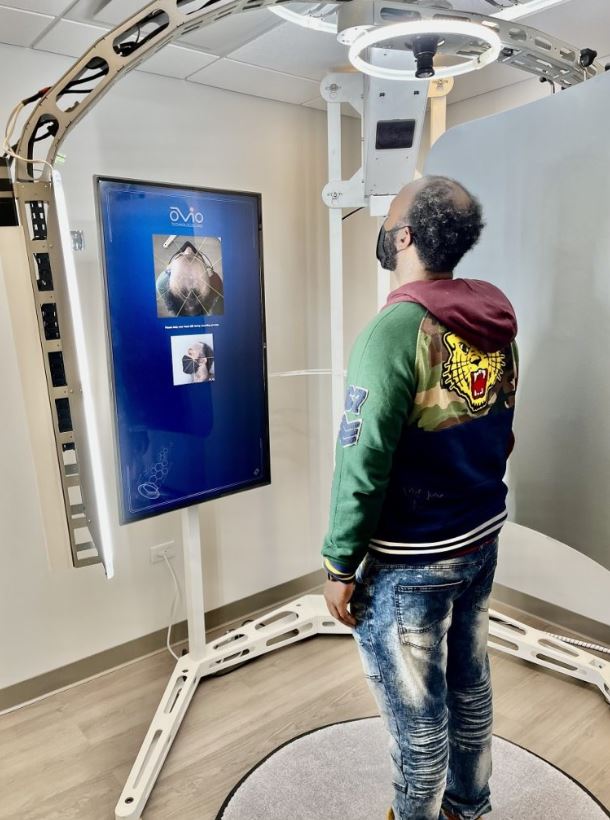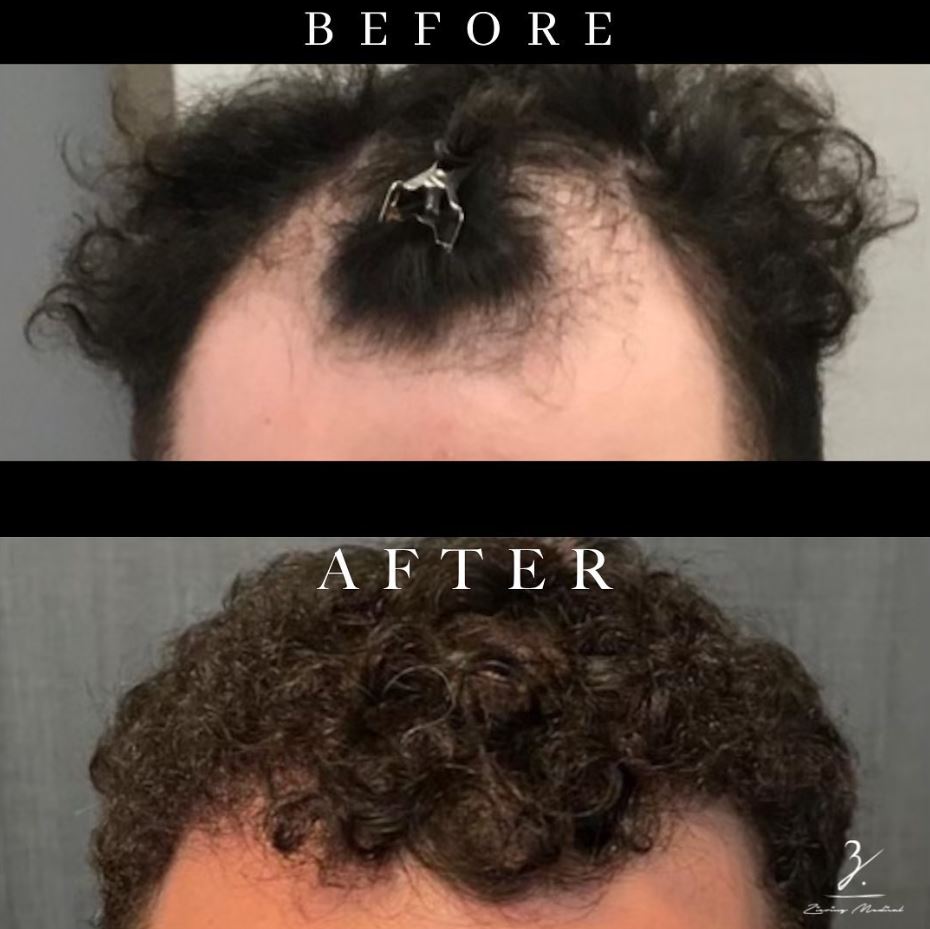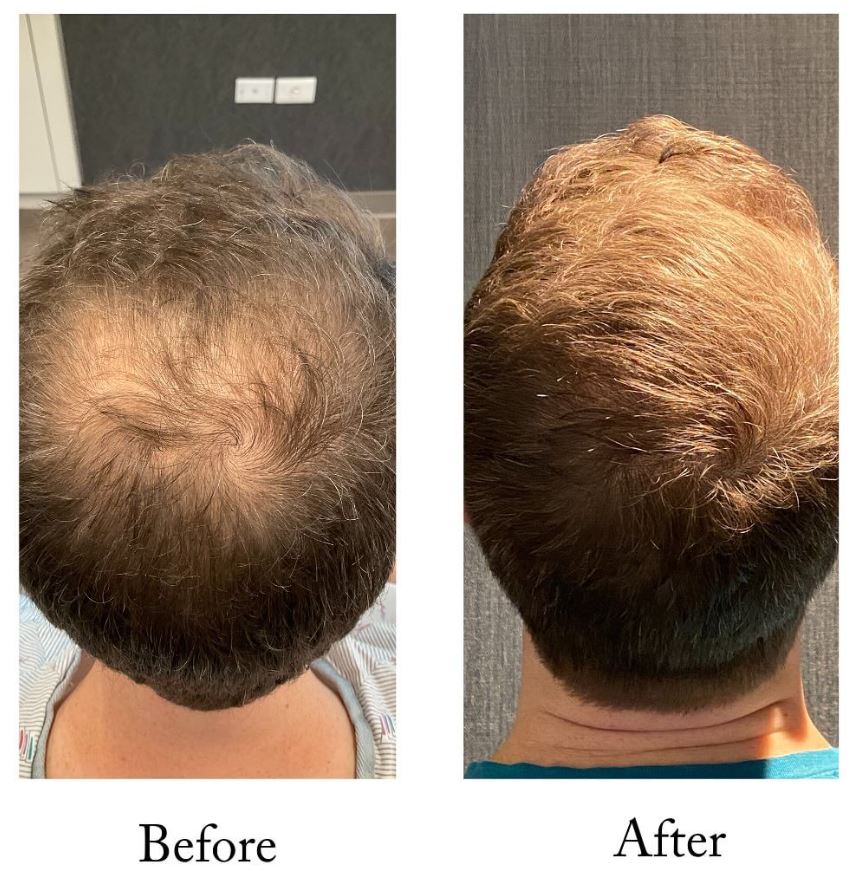Why Am I Losing Hair? Conditions That Lead to Hair Loss

Why Am I Losing Hair? Conditions That Lead to Hair Loss
At our practice, we see patients from all across the U. S. and different parts of the world, and one of the first things they ask is “What’s causing my hair loss?”
Often, patients experiencing balding have pattern hair loss, which is a hereditary type of hair loss, but it’s not the only culprit.
Hair loss can be caused by a lot of things.
Here Are The Most Common Conditions That May Result In Hair Thinning Or Balding
Male and Female Pattern Baldness
This type of hair loss is the result of your genes and is also referred to as genetic hair loss. It is the most common type of hair loss, and many individuals are predisposed to this condition.
If your family has a history of baldness, you will likely have it too. Men usually notice a receding hairline and thinning at the crown, while women tend to experience overall thinning or loss in the corners of their hairline.
What we know is that a hormone called dihydrotestosterone (DHT) shrinks the hair follicles, leading to premature hair loss.
Telogen Effluvium
Stressful events like illness, surgery, childbirth, or even severe emotional stress can trigger this condition.
It causes a large number of hair follicles to enter the resting phase too soon and this results in a sudden increase in hair shedding. The good news is, that it’s often temporary, and hair growth usually picks up again once the stressor is resolved.
However, if you experience prolonged thinning, we recommend consulting a hair loss specialist to find out what’s causing your hair loss.
Alopecia Areata
This autoimmune disorder causes patchy hair loss on the scalp and sometimes on other parts of the body.
The immune system mistakenly attacks hair follicles so it’s common to see round or oval bald spots in patients who have this condition. In more serious cases, it can progress to alopecia totalis, which causes complete hair loss on the scalp, or alopecia universalis, which affects hair on the entire body.
Traction Alopecia
With traction hair loss, also known as traction alopecia, the hair follicles are damaged due to constant pulling or tension, often from tight hairstyles like braids, ponytails, or even extensions.
Over time, this repeated strain weakens the follicles, leading to inflammation and eventually causing them to shrink and produce thinner hair.
If the tension continues, the follicles can become permanently damaged. Our surgeons usually consider nonsurgical treatments as the first course of action, but they most likely hair transplantation will be required to restore your hairline permanently.
Scarring Alopecia
Scarring alopecia, also known as cicatricial alopecia, is a group of rare disorders that destroy hair follicles and replace them with scar tissue, leading to permanent hair loss.
It typically presents as patches of hair loss with smooth, shiny skin, and may also be accompanied by symptoms like itching, burning, or pain in the affected areas. The condition can be challenging to diagnose as it often mimics other forms of alopecia in its early stages, but a biopsy is usually required to confirm the diagnosis.
Treatment focuses on halting the progression of the disease and often includes anti-inflammatory medications such as corticosteroids, immunosuppressants, or antimalarials. In cases where inflammation is controlled, hair transplantation might be considered, though it is not always successful due to the underlying scarring.
Frontal Fibrosing Alopecia (FFA)
Frontal Fibrosing Alopecia (FFA) is a type of hair loss that mostly shows up in postmenopausal women, though younger women and even men can sometimes be affected too. You’ll notice it as a slow receding of the hairline, especially around the front and sides, often forming a noticeable band of hair loss.
It’s not just the scalp that’s affected—eyebrows and sometimes even body hair can thin out too. The skin in these areas tends to look pale, smooth, and shiny, and you might also see some redness or scaling. Treating FFA is all about catching it early to slow down the hair loss, with options like topical steroids or medications that calm the immune system.
Central Centrifugal Cicatricial Alopecia (CCCA)
Central Centrifugal Cicatricial Alopecia (CCCA) is a type of hair loss that usually affects Black women, causing thinning or balding that starts at the crown of the head and gradually spreads outward.
It can be frustrating because it’s a form of scarring alopecia, meaning once the hair follicles are damaged, they can’t grow back. But there’s hope! Early treatment with anti-inflammatory medications, like topical steroids or antibiotics, can help stop the progression, and sometimes even save the surrounding hair.
It’s all about catching it early and working closely with a hair loss specialist. For individual situations, Scalp Micropigmentation (SMP) may be recommended to camouflage the balding and thinning areas.
Lichen Planopilaris (LPP)
Lichen Planopilaris (LPP) is a rare type of scarring alopecia where the immune system mistakenly attacks the hair follicles, leading to patches of hair loss that can be permanent if not treated early.
You might notice your scalp feeling itchy, painful, or red, with some areas looking smooth and shiny where hair used to be. The good news is, if caught early, treatments like topical steroids or oral medications that suppress the immune response can help stop further hair loss.
It’s all about working with your doctor to find the right treatment plan to keep the condition in check.
Medication-Induced Hair Loss
Certain medications, like chemotherapy drugs used for cancer treatment, can cause significant hair loss. However, other medications, such as blood thinners, antidepressants, and high blood pressure meds, can also contribute to thinning hair.
Nutritional Deficiencies
Not getting enough essential nutrients—especially iron, zinc, and biotin—can take a toll on your hair health. Iron deficiency anemia, in particular, is closely linked to hair loss.
Hormonal Imbalances
Issues with thyroid function (whether overactive or underactive) and conditions like polycystic ovary syndrome (PCOS) can throw off hormone levels and lead to thinning hair.
Certain Medical Conditions
Some medical conditions, such as lupus, psoriasis, and skin infections, can also interfere with hair growth. Hair will naturally grow back when they are treated.
Ways to Manage or Stop Ongoing Hair Loss
If you’re experiencing hair loss, don’t panic. At Ziering Medical, we provide the most advanced medical treatments to manage or stop ongoing hair loss or even regrow hair. However, you have to know that nonsurgical treatments may not stop hair loss permanently – especially for individuals with pattern baldness.
In such cases, our surgeons may recommend considering hair transplantation. They may also add nonsurgical treatments to your hair restoration plan to maximize results. Here are some nonsurgical treatments you can explore at Ziering Medical:
Topical and Oral Minoxidil
Minoxidil, found in treatments like Formula ZMIN, is applied to the scalp to stimulate hair growth by extending your follicles’ growth phase and increasing hair thickness. It’s effective for both men and women with pattern hair loss. Oral minoxidil is also available for those who want a more convenient option.
Finasteride
Finasteride directly counteracts DHT, the hormone responsible for shrinking hair follicles in male pattern baldness. Typically, 1 mg is recommended for men whereas 5 mg may be recommended for post-menopausal females.
Finasteride helps maintain hair density and promote regrowth, particularly in men. Patients typically see initial results within 3-4 months and more noticeable results upon continued use.
Important consideration: Finasteride is only approved for male pattern hair loss or in some instances post-menopausal women and requires a prescription and consultation with one of our Ziering hair loss specialists.
Dutasteride
Like Finasteride, Dutasteride is a DHT blocker, but it is more potent because it inhibits both types of the enzyme 5-alpha-reductase, which converts testosterone to DHT, whereas Finasteride only blocks one type.
This makes Dutasteride more effective at lowering DHT levels, which could lead to better outcomes for those who haven’t seen sufficient improvement with Finasteride alone. Someone might switch from Finasteride to Dutasteride if Finasteride isn’t providing the desired results in terms of slowing or reversing hair loss.
Dutasteride requires a prescription and a consultation with one of our Ziering physicians.
Laser Hair Therapy
This treatment uses low-level lasers to stimulate hair follicles, improving scalp blood flow and supporting healthy hair growth. It’s painless, safe, and available both in-clinic and at-home with the Z CAP.
Z-Factors
Z-Factors is a topical treatment containing exosomes, growth factors, proteins, and peptides to reduce inflammation, promote hair regeneration, and potentially reverse hair loss. It’s a quick, in-office procedure with no downtime, doesn’t require a blood draw, and offers a more comfortable alternative to PRP.
Who Should Consider Hair Transplantation
If you’re dealing with noticeable hair loss that isn’t responding to other treatments, and you have enough healthy donor hair to use for a transplant, we recommend considering a hair transplant. It’s a great option if your hair loss has stabilized, meaning it’s not rapidly progressing, and you’re looking for a permanent solution.
Of course, you’ll have to be in general good health for the best results and it’s important to have realistic expectations about what the procedure can do.
If this sounds like you, a personal consultation with one of our hair transplant surgeons can help you decide if a hair transplant is the right choice and if you are a good candidate.
Ziering Medical is proud to offer the most advanced techniques and tools for hair transplantation. If you do get a hair transplant at our practice, you will either qualify for FUE or MDEE hair restoration.
Your Ziering surgeon will recommend which method is best for you based on your available donor hair, scalp laxity, amount of hair loss, aesthetic goals, and preferences.
FUE Hair Transplant
Follicular unit extraction (FUE) is a minimally invasive technique where the hair is clipped down to a zero in the safe donor zone or the back and sides of the head, and the individual hair follicles are removed one-by-one from the donor area using a small punch tool.
Next, your hair transplant surgeon creates recipient sites in the balding and thinning areas, according to the agreed hair transplant design followed by the certified Tech Team gently placing those hair grafts at the proper angle, direction, and orientation into the recipient sites.
FUE typically results in minimal scarring and a shorter recovery time compared to the MDEE method, as it doesn’t involve removing a strip of scalp.
MDEE or Strip FUT Hair Transplant
Microscopically Dissected Elliptical Excision (MDEE), formerly known as Follicular Unit Transplantation (FUT), involves removing a thin strip of scalp from the donor area in the back of the head. This strip is then divided and dissected into individual follicular units, which are transplanted into the recipient sites created by the hair transplant surgeon.
While MDEE does leave a thin linear scar at the donor site, it allows for the collection of a large number of hair follicles in a single session and the scar can easily be concealed by the surrounding hair.
Unlike FUE, this surgical technique is preferred by many female hair transplant patients because it only requires shaving a narrow strip at the back and sides of the head, rather than the entire area.
What a Personal Consultation at Ziering Medical Looks Like.
The Ziering Medical Team is the opposite of the one-size-fits-all approach. Our world-class surgeons provide thorough hair loss evaluations and provide personalized care and hair restoration plans that work for you.
Our evaluation process includes:
- Detailed medical history: We’ll chat about your hair loss journey, any medications you’re taking, and any medical conditions you might have.
- Physical examination: Our surgeons will take a close look at your scalp to understand the extent of your hair loss and check for any underlying skin issues. To make our planning as precise as possible, we use the state-of-the-art Ovio Imaging System during your consultation.
- Diagnostic tests: We might suggest blood tests or a scalp biopsy to make sure there aren’t any underlying health concerns contributing to your hair loss.
Customized Treatment Plan: Your dedicated hair surgeon will develop a customized treatment plan utilizing the most advanced and innovative nonsurgical and surgical treatment solutions that will give you short and long-term strategies for managing your hair loss.erfect hairline performed by Dr. Ziering.

The Ovio Imaging System
This advanced system takes detailed photos that help us create and customize both short-term and long-term goals for your hair health, growth, and restoration. These images aren’t just useful for designing a personalized hair transplant plan; they also provide a benchmark to track your progress over the years.
Every Hair Restoration Story Started with A Consultation.
The thousands of patients who have restored their hair and confidence started their journey with a consultation at our practice. When you choose Ziering Medical, you are choosing a premium hair restoration clinic led by world-class hair transplant surgeons who produce the most natural-looking results.
Call us to book your consultation today. We serve patients all over the greater Tri-state area of New York, New Jersey, and Connecticut as well as the greater Southern California area from Los Angeles and Beverly Hills to Newport Beach and San Diego.
Hair Restoration Before & After Photos
These before and after photos show the skill and artistry of our hair transplant surgeons at Ziering Medical. See more life changing transformation like this in our gallery.



